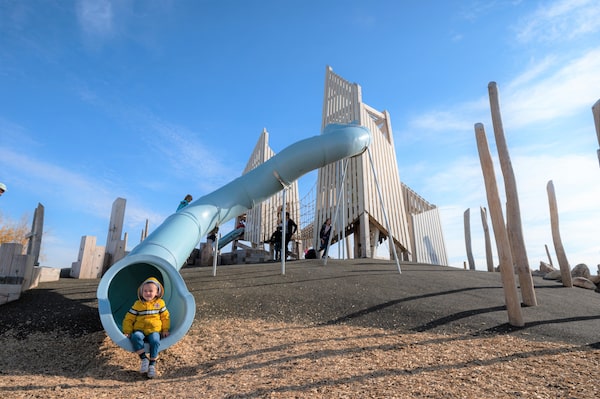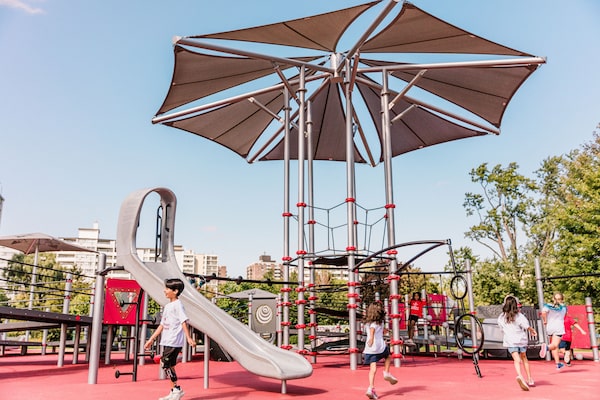Rainbow Park Ribbon playground.Brett Ryan/Handout
We spent hours last summer carefully assembling a climbing tower in our backyard to keep our active son busy. It was a hit – for a while. Then he grew bored once he could quickly climb to the top with minimal effort.
It’s a different story, though, when it comes to a pile of dirt and some large landscape rocks in a neglected corner. We had intended to fill the area in with grass and remove some of the “dangerous” rocks, but after watching our son, who’s now 6, and our daughter, 2, turn it into their favourite hangout, we’ve decided to keep it a bit wild. It’s dirty, unstructured, possibly even a little risky. And it keeps them busy for ages, in ways that our well-intentioned play structure just can’t.
It turns out this kind of nature-inspired play is backed by evidence as one of the best ways to engage kids of all ages and encourage them to be outside. And while traditional swings, slides and climbers still dominate most play spaces in Canada, there’s a growing move to embrace innovative, natural, complex play spaces that offer a challenge to kids of all ages and abilities.
“Particularly as kids get older, the standard playground tends to get quite boring for them quite quickly,” said Mariana Brussoni, director of the Human Early Learning Partnership at the University of British Columbia in Vancouver. “We’ve been giving a lot of thought to not only how you design playgrounds, but design cities to support kids playing where they choose.”
According to Brussoni, who studies risky play, kids quickly lose interest in traditional playgrounds because they offer little opportunity to be creative or inventive. She said there are three key ingredients to successful outdoor play: time, space and freedom. But all too often, kids aren’t able to access any or all of them.
A parent’s outdoor SOS kit: 10 must-haves to keep kids busy this summer

Wanuskewin playgrounds in Saskatoon.Matt Jacques/Handout
Creating a space for tots and teens
If play is the work of childhood, a growing chorus of researchers and designers say it’s imperative to create more spaces that offer the chance to experiment, take risks and face challenges.
“Play is the way that you learn,” said Matthew Urbanski, partner with landscape architects Michael Van Valkenburgh Associates, which has created some of the most creative parks in cities across North America.
Now, the company is working on ambitious plans for what is set to become the largest playground in Canada. The site, part of the Port Lands Flood Protection Project in Toronto, will be inspired by nature and incorporate elements of adventurous, risky play to capture the imagination and creativity of young people. It’s being intentionally designed so that toddlers as well as teens will feel comfortable sharing the space.
“The idea that you have a front yard kind of place for the city,” he said. “A jewel play space that brings kids together from across the city.”
Alex Bozikovic: Toronto’s new paradise for kids? It’ll take $50-million
While the firm has won award after award for their innovative park and play space design, they’ve also encountered resistance. For instance, part of the design of the now-iconic Brooklyn Bridge Park involved planting a variety of flowers. Urbanski was warned children would be likely to rip the flowers out of the ground. But he pressed on, saying that letting kids explore was the whole point and they could simply plant more flowers.
“Creating environments that foster play and discovery and self-determination and offer varying levels of risk, these are all really very important,” he said.
It’s no coincidence, then, that the playgrounds children never tire of include many of those elements: challenging landscapes, different textures, complicated climbing structures that are high off the ground, nooks where kids can hide.
Some of the best examples of these, as my kids will vouch, were built by Earthscape Play, a company based in Wallenstein, Ont., a short drive from Kitchener-Waterloo. Earthscape helped create Toronto’s Grange Park, which takes inspiration from its location near the Art Gallery of Ontario, incorporating elements of an artist’s studio with an array of areas for children to climb and explore. Then there’s Toronto’s St. James Park, which uses its proximity to St. Lawrence Market to create food-themed play experience, featuring giant asparagus stalks for climbing and a life-sized ice cream cone that has spilled, giving children the chance to crawl through it and jump on the small, spongy hills next to it that were made to resemble scoops of ice cream. Many of the play structures Earthscape brings to life include intricate, complicated places for kids to climb and move through.
Such environments add an element of surprise and, more importantly, risk, which is exactly the point, says Nathan Schleicher, Earthscape’s creative director.

Grange Park playgrounds in Toronto.Earthscape/Handout
How to add risk (without hazards) and encourage more play
Schleicher points out that there’s a huge distinction to be made between risks and hazards. A risk is something that poses a challenge to a child, such as taking a step between two structures high off the ground. A hazard is something inherently dangerous, such as a nail sticking out of a piece of wood. While hazards should be eliminated, Schleicher said that well-meaning adults are too eager to eliminate risks, which leads to boring playgrounds kids don’t want to visit.
And while it’s true that kids may fall and get hurt at a playground, the overall risks involved with young people not getting outside and being physically active are far greater, Brussoni said.
“Our concern around safety is not borne out by the reality of statistics,” she said.
Unfortunately, the majority of young people are not getting nearly enough physical activity outside, which can have lifelong consequences. A 2022 ParticipACTION report found that only one in four people between ages 5 and 17 are meeting national physical activity guidelines, which call for at least 60 minutes per day of moderate to vigorous physical activity. Physical activity tends to drop as children get older, in part because there are not enough opportunities for them to play, Brussoni said. Older kids lose interest in simplistic, traditional playground design and that’s why so many end up sitting on the sidelines.
Physical activity— the forgotten core area of child development during the pandemic
The lack of opportunity for play and physical movement can hit certain young people harder than others, such as children living in underserved areas. Many of the outdoor play areas at schools in Toronto are decades old and in need of repair. In more affluent areas of the city, fundraising efforts led by parents can help spur redevelopment of those spaces. But this isn’t equitable and as a result, outdoor play areas at many schools in lower-income areas are well overdue for improvements, said Richard Christie, senior manager of sustainability with the Toronto District School Board.
The good news is officials have prioritized upgrading play spaces in some of the most vulnerable sectors. This year, the board aims to complete its first 12 play space overhauls, he said.

Canadian Tire Jumpstart playground.Handout
Designing playgrounds for the future
The board is working with landscape architects to create outdoor environments that can help students learn and play. In addition to upgraded basketball courts and playground equipment, there will be a huge emphasis on planting trees, creating quiet spaces for students to take a calming break and providing opportunities for them to climb. Kindergarten students will have revamped learning spaces outside.
“We’re trying to not just replicate a traditional school grounds,” Christie said. “They’re not going to look like the typical school that you find in Ontario.”
And that also means ensuring playgrounds are accessible to all children. Kelly Arbour-Nicitopoulos, associate professor at the University of Toronto’s faculty of kinesiology and physical education, said Canada is far behind the U.S. and Europe in building play areas for everyone. For instance, playgrounds that sit on sand or wood chips are a no-go zone for people with mobility issues.
“Just because there’s an accessible swing doesn’t mean it’s an inclusive play space,” she said.
Similarly, many existing playgrounds can be difficult to navigate for neurodivergent kids or those with sensory issues. Improvements can include small, quiet spaces for kids to take a break, or equipment that makes noise to engage a child’s senses.
“That can really create an enriching play experience,” she said.
For our family, all this means we won’t be investing in any more store-bought play equipment. Instead, we are going to follow Urbanski’s advice: Let the kids play in the dirt, climb on the rocks and even add some wood logs to the mix so they can get even more creative. It’s going to be a fun summer.